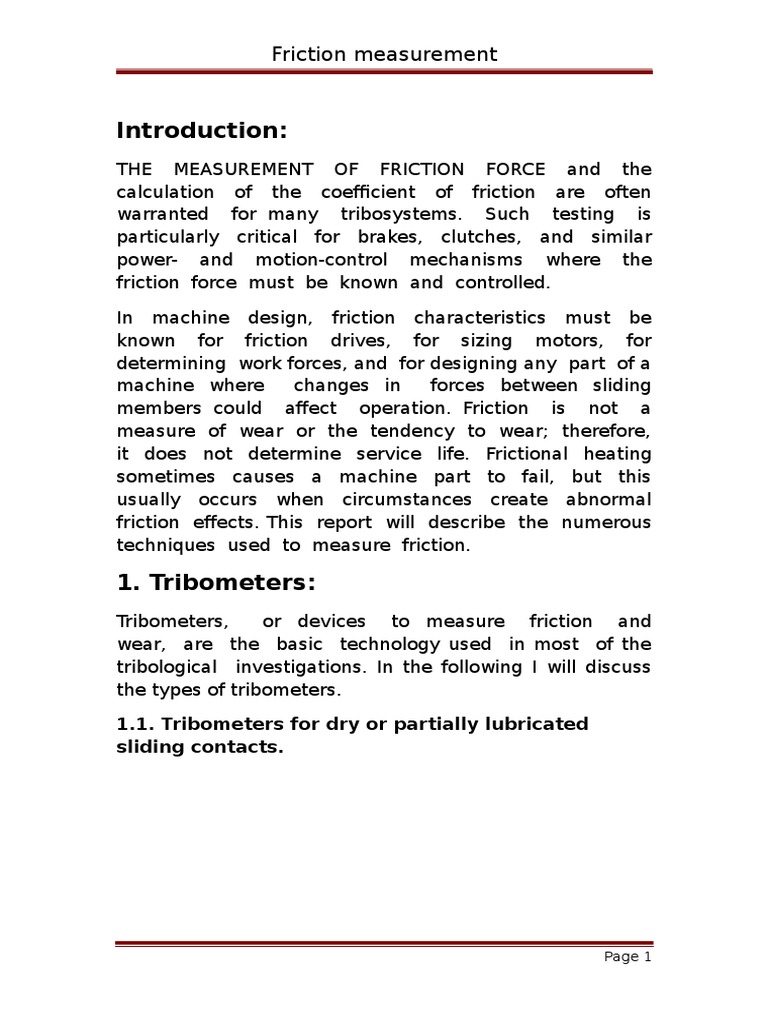Friction, an ubiquitous force in the physical world, is integral to understanding a plethora of phenomena, ranging from mundane activities like walking to complex interactions in industrial machinery. However, the inquiry into whether a precise unit exists for measuring friction reveals a multifaceted arena of scientific exploration. This discussion delves into the essence of friction, the nuances of its measurement, and the various factors influencing the frictional force.
At its core, friction is the resistive force that arises when two surfaces come into contact. The significance of friction in everyday contexts cannot be overstated; it not only facilitates motion but also poses challenges in applications such as automotive performance, material wear, and energy efficiency. Understanding and quantifying this force is pivotal for engineers, physicists, and material scientists alike.
To dissect the measurement of friction, one must first recognize that friction itself is a force, and thus, it is inherently measured in Newtons (N), the SI unit of force. This leads to an intriguing primary question: if friction is quantified in Newtons, how does one quantify the effectiveness or coefficient of friction, a term frequently employed in engineering contexts?
The coefficient of friction (μ) serves as a dimensionless scalar value that encapsulates the ratio of the force of friction (Ff) resisting motion to the normal force (N) pressing the two surfaces together:
μ = Ff / N
This critical parameter varies depending on the materials in contact and their surface conditions. The coefficient of friction can be categorized into two types: static and kinetic. Static friction pertains to the force required to initiate motion between stationary surfaces, whereas kinetic friction refers to the friction encountered when surfaces slide against each other. These distinct categories emphasize the nuanced nature of friction as a phenomenon.
Static friction generally exhibits a higher coefficient than kinetic friction, highlighting the role of adhesion and surface imperfections at the molecular level. Such variations lead to practical implications; for example, when designing tires, engineers prioritize materials that optimize the static coefficient to ensure grip during acceleration.
Moreover, several methodologies exist for quantifying these coefficients and by extension, understanding friction. Tribometers, specialized devices for measuring frictional forces, employ various configurations to apply controlled forces and measure resulting friction. These instruments can assess friction in dry, lubricated, or partially lubricated conditions, enabling a wide range of applications in research and manufacturing.
The choice of test method profoundly influences the resulting coefficients, as factors such as surface roughness, temperature, and environmental conditions play pivotal roles. For instance, the presence of lubricants typically decreases the coefficient of friction by forming a film that reduces direct contact between bearing surfaces. This phenomenon leads to a critical consideration in material selection, where the balance between minimizing wear and achieving effective grip becomes paramount.
Interestingly, the concept of friction encompasses more than mere material interactions; it also intersects with thermodynamics. Friction generates heat, a factor often underestimated in the design of mechanical systems. Increased frictional forces not only lead to energy loss but also raise temperatures, which can precipitate material degradation or failure. When considering friction in a broader context, it becomes evident that optimizing frictional properties is indispensable for enhancing the longevity and efficiency of mechanical components.
Research in the field of tribology—the study of friction, wear, and lubrication—has yielded remarkable insights. Advanced materials, such as composites and nanostructured coatings, have been developed to modify frictional behavior, enabling better performance across diverse applications. Innovations in nanotechnology have led to the creation of surfaces engineered at the molecular level, significantly altering friction characteristics.
Environmental factors must also be acknowledged when measuring and interpreting friction. Humidity, temperature fluctuations, and contaminants can influence surface properties and modify the effective coefficient of friction. For example, wet conditions typically reduce friction between surfaces, necessitating a recalibration of expectations in safety-critical fields such as automotive or aviation engineering.
As scientific inquiry progresses, the quest for an overarching metric to encapsulate the complexities of friction continues. While the Newton remains the foundational unit of measure, the quest for understanding friction transcends a mere numeric value; it invites exploration into the deeper principles governing physical interactions. The coefficient of friction, although dimensionless, stands as a critical bridge connecting theoretical models with practical applications.
Ultimately, the measurement and management of friction are paramount not only for industrial applications but also for advancing scientific knowledge. As technology evolves, the ability to quantify friction with increasing precision will enhance our capacity to innovate and improve performance across diverse domains. Thus, one may conclude that while the unit of measurement for friction may be straightforward, the underlying principles and implications offer a profound landscape for exploration and understanding.
In summary, the inquiry into the measurement of friction unveils a rich tapestry of scientific concepts that extend far beyond mere numeric values, illuminating the intricate relationships by which our world operates. Whether in everyday scenarios or groundbreaking technological advancements, the delicate balance of frictional forces continues to inspire curiosity and drive further investigation into the fundamental laws of physics.










